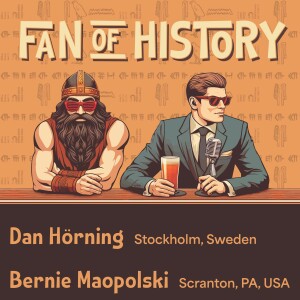
From 2020. There is no WNIH this week so we figured we would present to you the episode Dan is most proud of in the entire history of Fan of History. Naturally the patrons on Patreon does not get charged anything for this rerun of episode 101.
Archaeologist Reidar Magnusson, specialized in Northern Europe 1000-500 BC, joins Dan to talk about what was really going on in the North during the end of the bronze age. Reidar sheds new light from recent findings on this exciting era in the area. Hinduism-style burials, a gigantic battle among professional soldiers that nobody knows who they were, the death of 90% of the population by an unknown agent, the best bronzecrafting in the world and much, much more. Join us for a special episode when we go deep into the secrets of the late bronze age of the north. Full text below!
This is a podcast by Dan Hörning and Bernie Maopolski.
Archaeology
As there are no written sources that reliably describe any parts of northern Europe before the Roman expansions the material for this episode of the podcast in entirely based on archaeological finds and research. History, in the meaning of written sources, is available in Scandinavia from around 1000 A.D. In other parts of northern Europe a few hundred years earlier. Archaeology is a social science that use scientific methods for dating, provenance analysis, sample analysis etc. A lot of information can be determined from human bones, and DNA techniques gives even more opportunities, that presently are too costly to be used in any larger scale.
The finds from settlements sites from this era are the covered post-holes from the longhouses and some hearths and storage pits together with some pottery, bones and occasional Iron tools. Graves from this period are for the most part discreet and seldom containing gifts. The keys to understand this period likely lies in the more special sites of the period, the bronze deposits, the heaps with fire-cracked stones and the occasional cult sites.
The end of the Bronze Age
During this period this part of the world to the most part transit between the Bronze Age and the Iron Age. Traditionally the break between the Bronze Age and the Iron Age take place around 500 B.C. in the Nordic Bronze Age culture but in reality iron have replaced the bronze for cutting edges around 800 B.C. A fact that even one of the pioneers in early Swedish archaeology, Oscar Montelius, confirms. In Britain and in rest of northern and central Europe, for example Hallstatt culture in Austria, the transit takes place around the same time. Iron-working have been known in these regions for several hundreds of years at that point. For example: the oldest evidences of Iron-working in present-day Sweden are from around 1100 B.C. Worth mentioning is that the oldest evidence for bronze working from the same region is just a few hundreds of years older.
However, even if the changes in metal working does correlate with a shift in the society of the time it´s most likely not the cause of the change. And the introduction of iron does not diminish the use of Bronze in most cases. It´s relevant to question whether the transit from bronze to iron had any greater significance at all in a larger scale.
Settlement patterns
The society of the time had a strong maritime focus. All settlements where situated in the vicinity of waterway, but often not directly by the shores. Settlements where almost exclusively single household farms, with a few exceptions that are perhaps hamlets. One example of that is Apalle outside today’s Bålsta in Sweden, that is the largest excavated...
If you like what we do you can support the Fan of History project on
https://www.patreon.com/fanofhistory (and you don't get charged for reruns or even regular episodes of What's new in History)
Support the show and listen ad-free to all of the episodes, including episode 1-87. Click here: https://plus.acast.com/s/history.
Hosted on Acast. See acast.com/privacy for more information.
More Episodes
 2023-11-15
2023-11-15
 2023-11-01
2023-11-01
 2023-10-18
2023-10-18
 2023-09-13
2023-09-13
 2023-08-23
2023-08-23
 2023-07-26
2023-07-26
 2023-07-12
2023-07-12
 2023-06-28
2023-06-28
Create your
podcast in
minutes
- Full-featured podcast site
- Unlimited storage and bandwidth
- Comprehensive podcast stats
- Distribute to Apple Podcasts, Spotify, and more
- Make money with your podcast
It is Free
- Privacy Policy
- Cookie Policy
- Terms of Use
- Consent Preferences
- Copyright © 2015-2024 Podbean.com





